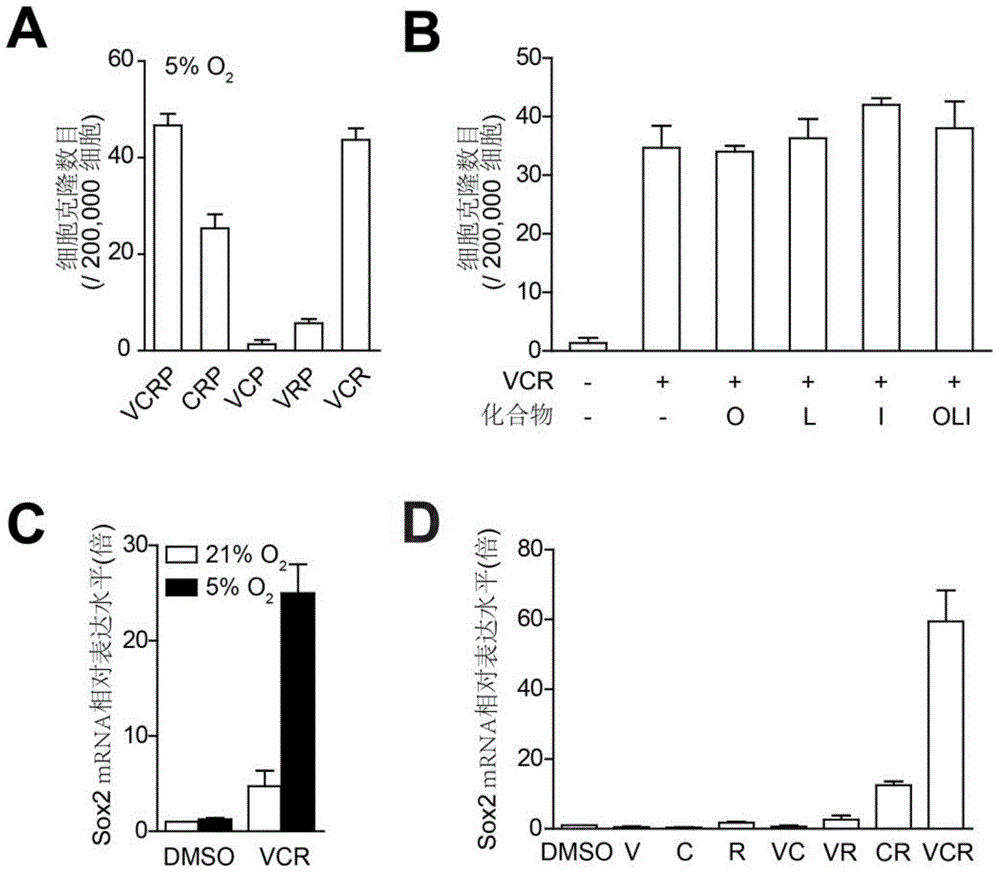Method for inducing transdifferentiation of somatic cells into neural stem cells and application thereof
A technology of neural stem cells and small molecule compounds, which is applied in the fields of biotechnology and neurodevelopment, and can solve problems such as foreign gene intervention and clinical safety hazards
- Summary
- Abstract
- Description
- Claims
- Application Information
AI Technical Summary
Problems solved by technology
Method used
Image
Examples
Embodiment 1
[0139] Example 1 Screening Compound Combinations for Inducing Somatic Cells to Produce Neural Stem Cells under Normal Physiological Hypoxic Conditions
[0140] 1.1 Screening the clones formed by VPCR combination cultured somatic cells under normal physiological hypoxia
[0141] Through a large number of composition screening, it is basically determined that the combination of VPCR (VPA, CHIR99021, Repsox and Parnate) at 3% or 5% O 2 Treat mouse fibroblasts under the condition of about 10 days to produce dense clones, but under the condition of 21% O2, no dense clones can be produced ( figure 1 A). About 40 compact clones can emerge from 200,000 starting cells. The induction efficiency of intermediate clones was at 5% O 2 relative to 3%O 2 The condition is slightly higher, therefore, 5% O is used in subsequent induction experiments 2 cultivation conditions.
[0142] 1.2 AP staining of cell clones in 1.1
[0143] Alkaline phosphatase AP staining of these intermediate clones...
Embodiment 2V
[0148] Example 2 Detection of characteristics of VCR-treated cell clones
[0149] 2.1 Expression of Sox2 under different oxygen pressure
[0150] Sox2 expression could not be effectively induced under normoxic conditions or with other compound combinations lacking Repsox, CHIR99021 or VPA ( figure 2 C and 2D)
[0151] 2.2 Expression of different neural stem cell-related genes in cell clones
[0152] Such as image 3 As shown in B, the mouse fibroblasts were treated with VCR under normal physiological hypoxic conditions, and it was found that the expression of Sox2 was significantly increased on the 5th day, reached the peak on the 10th day, and fell slightly on the 15th day; while Oct4 and Nanog The expression of was only slightly increased on the 10th day.
[0153] Conclusion: Small molecular compound combination VCR can be used in 5% O 2 Normal Physiological Hypoxic Conditions Facilitate Transdifferentiation of Mouse Embryonic Fibroblasts to Intermediate Dense Clones. ...
Embodiment 3
[0154] Example 3 Neural stem cell differentiation of VCR-treated cell clones
[0155] 3.1 Morphological observation of cultured clones
[0156] Under normal physiological hypoxic conditions, the cells treated with the VCR combination for about 10 days were digested and re-plated, and cultured in the neural stem cell medium containing heparin, epidermal growth factor EGF, and basic fibroblast growth factor bFGF. After about 7-10 days, neural stem cell-like bipolar morphology appeared in the cultured cells ( image 3 C).
[0157] 3.2 Neural stem cell-specific gene detection
[0158] Neural stem cell marker genes Nestin, Sox2 and Pax6 can be detected by immunofluorescence staining ( Figure 4 A). Further, reverse transcription polymerase chain reaction detected that the expression levels of neural stem cell-specific genes including Sox2, Pax6, Blbp, Ascl1 and Brn2 were also enhanced ( image 3 D, ciNPCp1).
[0159] Conclusion: Neural stem cell-like cells appeared in the cul...
PUM
| Property | Measurement | Unit |
|---|---|---|
| thickness | aaaaa | aaaaa |
Abstract
Description
Claims
Application Information
 Login to View More
Login to View More - R&D
- Intellectual Property
- Life Sciences
- Materials
- Tech Scout
- Unparalleled Data Quality
- Higher Quality Content
- 60% Fewer Hallucinations
Browse by: Latest US Patents, China's latest patents, Technical Efficacy Thesaurus, Application Domain, Technology Topic, Popular Technical Reports.
© 2025 PatSnap. All rights reserved.Legal|Privacy policy|Modern Slavery Act Transparency Statement|Sitemap|About US| Contact US: help@patsnap.com



